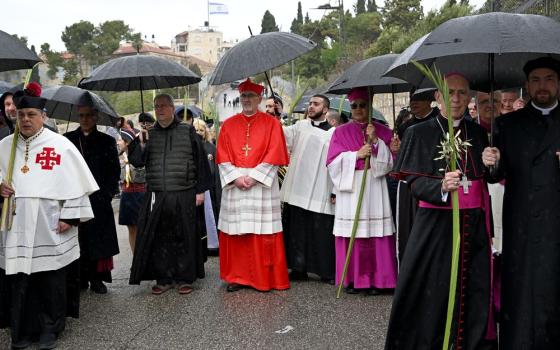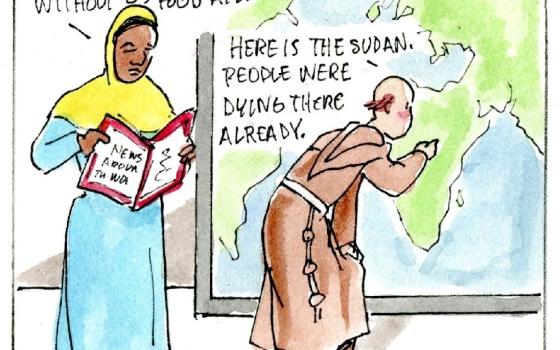Monsignor Guido Marini, Benedict XVI’s Master of Pontifical Liturgical Celebrations, is one of those Vatican figures who normally operate in the shadows. He’s the guy who organizes the Masses and other liturgical events over which the pope presides, so he generally attracts notice only when he happens to be standing near his boss when the TV cameras light up.
Marini took a big step into the spotlight back in January, however, when he gave a speech to a meeting of English-speaking priests in Rome, in which he advocated a liturgical “reform of the reform.” Those comments unleashed a wave of speculation in the blogosphere and in liturgical circles about a possible new overhaul of Catholic worship under Benedict XVI, which critics would read as “rolling back the clock” on reforms associated with the Second Vatican Council (1962-65).
Marini sat down for an exclusive interview with NCR in his Vatican office on Feb. 9, to explain what he had in mind by a “reform of the reform.”
Read John Allen's news story here: Liturgist: Pope aims to 'propose' practices
In a nutshell, Marini’s message was that under Benedict XVI, the winds are clearly blowing in a more traditional direction, but anyone expecting a dramatic lurch one way or the other is likely to be disappointed – this pope prefers to operate by “proposing,” Marini said, rather than “imposing.”
The following are excerpts from the interview with Marini. (Marini spoke in Italian, and was given an opportunity to review the English translation of his remarks.)
* * *
What did you have in mind on January 6 when you talked about a “reform of the reform”?
To tell the truth, I didn’t use this expression as something of my own, but as a phrase used by several others for many years, including, of course, the former Cardinal Ratzinger. I didn’t want to get into the details of what various people might mean by the expression, because there are different ways of understanding it. I believe that the best way, the most correct way, to understand the expression is certainly not to reject the reforms determined by the Second Vatican Council. Rather, it’s to take another step forward in the comprehension and experience of an authentic liturgical spirit, carrying together the inheritance of our tradition with the reform that the council accomplished, in a spirit of development in continuity.
Of course, the former Cardinal Ratzinger also once warned against new upheavals in the liturgy, saying that we need a period of stability. Do you agree?
Yes, yes … I’m fully in agreement! I don’t believe that the liturgy of the church needs any radical changes or distortions, in part because it’s not in the logic of this spirit of development in continuity. I believe instead that it’s a matter of consolidating what already exists, in a more authentic way, according to the true mind of the church.
There is no “rollback” on Vatican II?
Of course not. A ‘rollback’ wouldn’t make sense, because it’s not how the life of the church works. The life of the church moves forward in time, always developing but without losing anything from its life of either the past or the present.
You spoke about some more traditional touches in Pope Benedict’s liturgies, such as placing a cross on the altar and giving communion on the tongue. If I understand correctly, you’re not suggesting that these are harbingers of new liturgical policy for the whole church.
The pope has proposed, and proposes, these solutions. It’s the style of the present pope to proceed not though impositions but propositions. The idea is that, little by little, all this may be welcomed, considering the true significance that certain decisions and certain orientations may have. That seems to me a typical touch of Pope Benedict.
Whether sometime in the future, what the pope’s presenting in this propositional way should become more of a disciplinary norm, we don’t know and can’t say. Certainly, the style at the moment is to offer proposals for the celebrative style of the church. Nevertheless, when the Holy Father proposes, it is not simply his personal preference, but a precise and clear orientation for the whole church.
That raises a broader question. Benedict XVI clearly has a strong liturgical vision, but to date hasn’t launched any sweeping liturgical reform. You seem to have already suggested why not: His strategy is to propose rather than impose. Is that right?
I would say so, yes. It seems to me that he has a vision rooted in great faith in the life of the church, which of course has its own sense of time and its own rhythms. Given certain realities, as well as the times in which we live, sometimes things can’t just be imposed quickly. They have to slowly enter into the way of thinking of the church, its way of feeling, its climate. Within that, maybe one can eventually arrive at providing a more precise disciplinary norm, but perhaps first it is helpful to shape a climate of opinion.
You have to shape the culture of the church before its legislation?
I believe so, even if the two things obviously have to go together, because disciplinary norms also help to shape a culture. At the same time, there’s a process of cultural formation that can lead to disciplinary norms. I believe the balance between these two moments has to be kept in mind.
The new edition of the Roman Missal in English is about to come out. Have you seen it?
No. As you know, that’s a job for the Congregation for Divine Worship. I know that it’s moving forward.
Will the pope use the new missal when he’s in England in September?
I don’t know, because it hasn’t yet been decided. We don’t know if by then it will already be definitively approved. Certainly if it’s approved in the meantime, it would be the text he uses.
The new translation has sometimes been criticized for using unfamiliar terms that may not be readily accessible to people. Do you agree with the logic that sometimes a kind of ‘sacral speech’ is a good thing, in order to lift people out of their daily experience?
I believe so, yes. The liturgy certainly has a popular dimension, but it also has its own language and its own frame of reference. We sometimes need help in considering that in the liturgical space, in the climate of the liturgy, we effectively enter another dimension which is not our every-day world. The pope often speaks of the liturgy as a kind of heavenly space, which is certainly not detached from the world, but in fact offers a new way to live the experience of the world. This all has to go together, and sometimes it can be expressed in language that isn’t the speech of everyday life, but the language of prayer and spirituality, which has its own beauty.
With his 2007 motu proprio, Benedict XVI authorized wider celebration of the old Latin Mass, the so-called “Tridentine Rite,” alongside the new. Now that the dust has settled on that decision, where do things stand?
In my opinion, what’s important now is that the two forms of the Roman rite look upon one another with great serenity, realizing that both belong to the life of the church and that neither is the only true, authentic expression. But rather, the two forms of Roman Rite can mutually enrich each other. This must be the path along which we should walk, because perhaps we haven’t yet truly arrived at this attitude of serenity and welcome in daily life.




